Click on images to enlarge
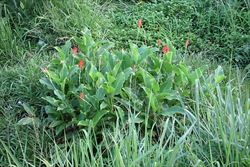
infestation in a waterway (Photo: Sheldon Navie)
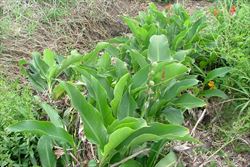
infestation in a drainage channel (Photo: Sheldon Navie)
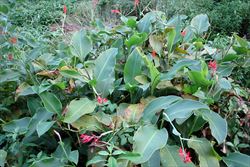
clumping habit (Photo: Sheldon Navie)
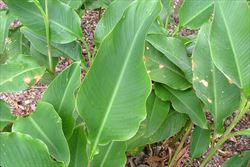
large leaves (Photo: Sheldon Navie)
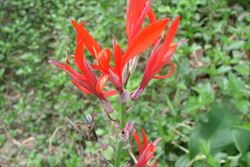
flower cluster (Photo: Sheldon Navie)
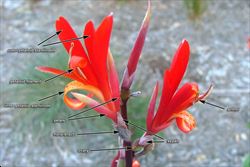
flowers with different parts indicated (Photo: Sheldon Navie)
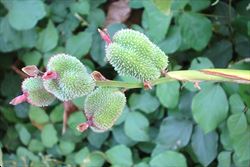
immature fruit covered in numerous tiny projections (Photo: Sheldon Navie)
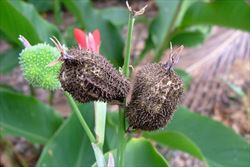
mature fruit (Photo: Sheldon Navie)
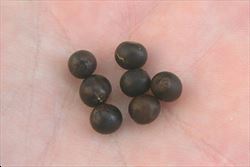
close-up of seeds (Photo: Sheldon Navie)
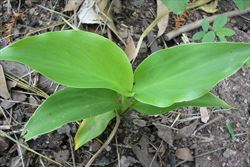
young plant (Photo: Sheldon Navie)
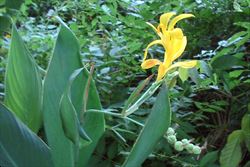
habit of the yellow-flowered form (Photo: Sheldon Navie)
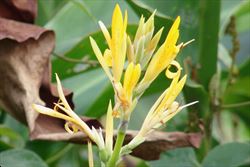
yellow flowers (Photo: Forest and Kim Starr, USGS)
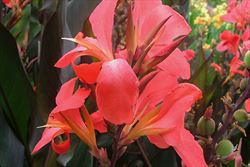
the flowers of garden canna (Canna x generalis), with upright petals (Photo: Sheldon Navie)
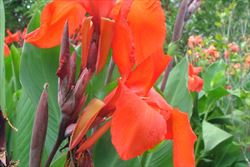
the flowers of orchid canna (Canna x orchioides), with petals bent backwards (Photo: Sheldon Navie)
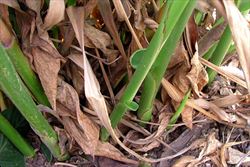
upright stems enclosed in leaf sheaths (Photo: Sheldon Navie)
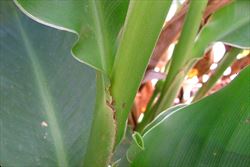
close-up of base of leaf blades (Photo: Sheldon Navie)
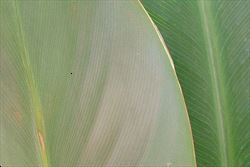
close-up of leaf underside (Photo: Sheldon Navie)
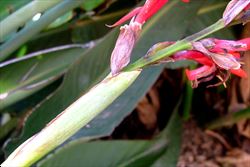
close-up of leafy bracts at the base of the flower cluster (Photo: Sheldon Navie)
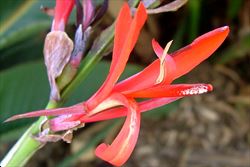
close-up of flower (Photo: Sheldon Navie)
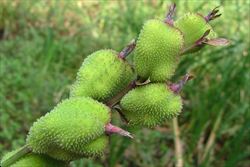
close-up of immature fruit with persistent sepals (Photo: Sheldon Navie)
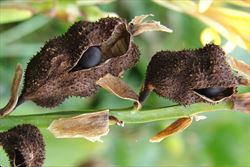
close-up of mature fruit with seeds (Photo: Forest and Kim Starr, USGS)
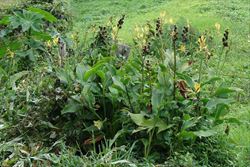
habit of the yellow-flowered form (Photo: Forest and Kim Starr, USGS)
Scientific Name
Canna indica L.
Synonyms
Canna coccinea Mill.Canna edulis Ker-Gawl.Canna lutea Mill.
Family
Cannaceae
Common Names
African arrowroot, canna, canna lily, edible canna, Indian canna, Indian shot, purple arrowroot, Queensland arrowroot, red canna, Sierra Leone arrowroot, tous-les-mois arrowroot, wild canna
Origin
Native to tropical America, but its exact native range is obscure. Considered to be native to Mexico, Central America (i.e. Belize, Costa Rica, El Salvador, Guatemala, Honduras, Nicaragua and Panama), the Caribbean and tropical South America (i.e. French Guiana, Guyana, Surinam, Venezuela, Brazil, Colombia, Ecuador, Peru, Argentina, Paraguay and Uruguay).
Cultivation
Commonly cultivated as a garden ornamental, particularly in the warmer parts of Australia.
Naturalised Distribution
Naturalised in many parts of eastern and south-eastern Australia. It is common in south-eastern Queensland and in the coastal and sub-coastal districts of New South Wales. Also present in northern Queensland, south-eastern South Australia, and on Norfolk Island and Christmas Island.
Also naturalised in New Zealand, southern USA, Hawaii and on several other Pacific islands.
Habitat
A weed of waterways, lakes, ponds, swamps and other wetland habitats. Sometimes also found growing in old gardens, disturbed sites and waste areas.
Habit
A large, long-lived (i.e. perennial) herbaceous plant growing up to 2 m tall and spreading laterally by means of fleshy underground stems (i.e. rhizomes).
Distinguishing Features
- a large, long-lived, clump-forming, plant with fleshy roots.
- its very large green leaves sheath the stem at their bases.
- its red and/or yellow flowers are borne in clusters at the top of its stems.
- these flowers have five relatively narrow 'petals'.
- its fruit are covered in lots of small projections and are topped by three persistent sepals.
Stems and Leaves
The upright (i.e. erect) stems (1-2 m tall) are sturdy, hairless (i.e. glabrous) and green in colour.
The alternatively arranged leaves consist of a stem-clasping sheath at the base and very large, spreading, leaf blade (20-60 cm long and 10-30 cm wide). The leaf blades are elongated or oval (i.e. elliptic) in shape but come to a point at the tip (i.e. they have acute or acuminate apices). They are hairless (i.e. glabrous), have entire margins, and narrow at the base where they join to the top of the leaf sheath.
Flowers and Fruit
The flowers can be either red, yellow or occasionally red and yellow (i.e. yellow with red spots or vice versa) and are quite showy. They are borne singly or in pairs (i.e. monochasial cymes) and arranged into larger branched clusters (i.e. with 6-20 flowers) at the tips of the flowering stems. Each flower appears to have five 'petals' but these are actually other floral structures (i.e. staminodes and petaloid filaments) that have become modified to imitate petals. The petals are actually the three bract-like structures below these false 'petals' (4-6.5 cm long and 0.4-0.7 cm wide). They are fused together at the base (i.e. into a perianth tube 5-15 mm long) and their margins are curved inwards. Each flower has three slightly different types of false 'petals' (i.e. three outer staminodes, an inner staminode and a petaloid filament). The three outer staminodes are relatively broad (3.5-6 cm long and 0.5-1.5 cm wide) while the inner staminode (i.e. labellum) is usually somewhat narrower (up to 4-5 cm long and 0.8 cm wide) with its tip bent backwards (i.e. it has a recurved apex). The single petaloid filament is narrower again (3-4 mm wide) and has an anther about 10 mm long about half way up one of its sides. Each flower also has three narrow sepals (9-17 mm long and 2-5 mm wide) and their bases are also surrounded by a floral bract (5-30 mm long and 5-15 mm wide) and bracteoles (5-20 mm long and 3-8 mm wide). Flowering occurs mainly during spring and summer.
The papery capsules (1.5-3 cm long and 1.5-2 cm wide) are oval (i.e. ellipsoid) to almost rounded (i.e. sub-globose) in shape and are crowned by the persistent sepals. They are initially green or purplish in colour and covered in numerous short projections (i.e. they are verrucose), but turn brown as they mature and may lose some or all of their tiny projections. They split open at maturity to release numerous smooth, black, rounded (i.e. spherical) or egg-shaped (i.e. ovoid) seeds. These seeds are relatively large (5-8 mm long and 4-7 mm wide) and very hard. Fruiting occurs mainly during summer and early autumn.
Reproduction and Dispersal
This species reproduces by seed and vegetatively via its fleshy underground stems (i.e. rhizomes).
The seeds are thought to be dispersed by birds, while the seeds and rhizomes may also be spread by floods and in dumped garden waste.
Environmental Impact
Canna lily (Canna indica) is regarded as an environmental weed in New South Wales and south-eastern Queensland. It is mainly found north from Macquarie Pass in New South Wales, and is of particular concern in the Sydney, Blue Mountains, and North Coast regions. However, this garden escape is probably most common and invasive in south-eastern Queensland, where it appears on the list of the 200 most invasive weeds. It is considered an environmental weed because it forms large dense clumps, particularly along waterways, and replaces native aquatic and wetland species.
It is also regarded as an invasive species in other parts of the world and is listed in the Global Invasive Species Database. In Hawaii and Fiji it also becomes naturalised in disturbed wetter forests and in forest clearings.
Other Impacts
Because canna lily (Canna indica) forms dense clumps in waterways and along the margins of water bodies, it can restrict water movement, cause flooding, and limit access to these areas. In Hawaii it also a weed of plantation crops (e.g. coconut).
Legislation
Not declared or considered noxious by any state government authorities.
Management
For information on the management of this species see the following resources:
- the New South Wales Department of Primary Industries Noxious and Environmental Weed Control Handbook, which can be downloaded from http://www.dpi.nsw.gov.au.
Similar Species
Canna lily (Canna indica) is very silimar to the garden cannas (i.e.Canna x generalis and Canna x orchiodes), which have both also become naturalised in Australia. These species can be distinguished by the following differences:
- Canna lily (Canna indica) has five false 'petals' (i.e. four petaloid staminodes and a petaloid filament) that are relatively narrow (less than 15 mm wide). Its actual petals are fused together at the base and form a relatively short tube (5-15 mm long). These petals do not become reflexed after the flowers have been open for some time.
- garden canna (Canna x generalis) has five false 'petals' (i.e. four petaloid staminodes and a petaloid filament) that are relatively broad (15-55 mm wide). Its actual petals are fused together at the base and form a relatively short tube (5-15 mm long). These petals do not become reflexed after the flowers have been open for some time.
- garden canna (Canna x orchiodes) has five false 'petals' (i.e. four petaloid staminodes and a petaloid filament) that are relatively broad (15-60 mm wide). Its actual petals are fused together at the base and form a relatively long tube (20-50 mm long). These petals become reflexed after the flowers have been open for some time.

